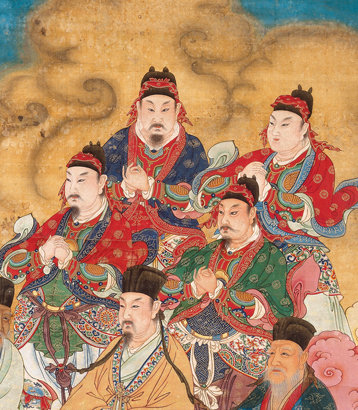Tao
dal 29/3/2010 al 4/7/2010
Segnalato da
29/3/2010
Tao
Galeries nationales du Grand Palais, Paris
The topics explored in this exhibition will give visitors an opportunity to understand the philosophical, poetic, religious and scientific approaches which make taoism "another way of being", whose ultimate aim is akin to the search for a harmonious, durable rapport between man and the universe. With an array of 250 works - painting, sculpture, ceramics, bronze and textiles - the show traces the expression of taoism over the centuries through a few founding themes and presents beautiful items from the Musee Guimet, and other collections in Europe, the US and Taiwan in a transversal display.

An exhibition organised by the Réunion
des Musées Nationaux and the Musée
national des Arts Asiatiques Guimet.
Curated by: Catherine Delacour, chief curator, Musée National des Arts Asiatiques Guimet, Paris
Interested in all forms of creation and particularly open to the great civilisations, the
Galeries nationales, in conjunction with the Musée des Arts Asiatiques Guimet, are preparing
Europe’s first great exhibition on taoism.
Tao, Another Way of Being will introduce a western public to a mode of thought and conception
of mankind in the universe which are fundamentally foreign to them. Certainly, many have
already heard of taoism, or yin and yang with its elegant graphic symbol, or the open air
gymnastics and breathing exercises known as qi gong. But despite its charm, taoism remains
obscure. The topics explored in this exhibition will give visitors an opportunity to
understand the philosophical, poetic, religious and scientific approaches which make taoism
"another way of being", whose ultimate aim is akin to the search for a harmonious, durable
rapport between man and the universe.
With an array of 250 works – painting, sculpture, ceramics, bronze and textiles – the
exhibition traces the expression of taoism over the centuries through a few founding themes
and presents the most beautiful items from the Musée Guimet, and other collections in Europe,
the United States and Taiwan in an unusual, transversal display. Often unfamiliar or used out
of their proper context, these works take on their full meaning in the exhibition.
Taoism is not a religion in the usual sense, that is, subservient to a single god and creator,
but more simply a life style, a state of mind which accepts many different attitudes and
schools.
Taoism is a mode of thought which exalts life and gambles on the happiness of beings on earth
and beyond. It supports its theories with the image of the radiant joy that illuminates the
saint from within and beams out to all beings.
The philosophical foundations of taoism were already laid in Chinese society long before
"religious taoism" developed in the late 2nd century AD. It was structured like a real
religion, with a pantheon, sacred texts, a priesthood, organised parishes, temples and
followers.
It was the later development of Confucianism, then the intrusion of Buddhism, combined with
other historic events, which prevented Europeans from seeing the religious and cultural
importance of taoism in China. The reprinting and distribution of the sacred texts of the
taoist canon in 1926, at a time when it seemed doomed to disappear, launched a major effort of
translation, analysis and interpretation which brought taoism back into the concert of the
world’s religions.
Image: Paysage avec pavillon, Album de cinq feuilles, musée Guimet – musée des Arts asiatiques, Paris
© musée Guimet, Paris, Dist. Rmn / Ghislain Vanneste
The exhibition is supported by Macif
Press contact:
Rmn 49 rue Etienne Marcel 75039 Paris, cedex 01
Florence Le Moing t 01 40134762 florence.le-moing@rmn.fr
Elodie Vincent t 01 40134761 elodie.vincent@rmn.fr
Galeries nationales, Grand Palais
Clemenceau entrance
3, avenue du Général Eisenhower 75008 Paris
Open:
Every day (except Tuesdays) from 10 am to 8 pm, late night on Wednesdays until 10 pm. Closed on 1 May.
Admission:
€ 11, concession € 8 (visitors aged 13-25, job seekers, large families)



